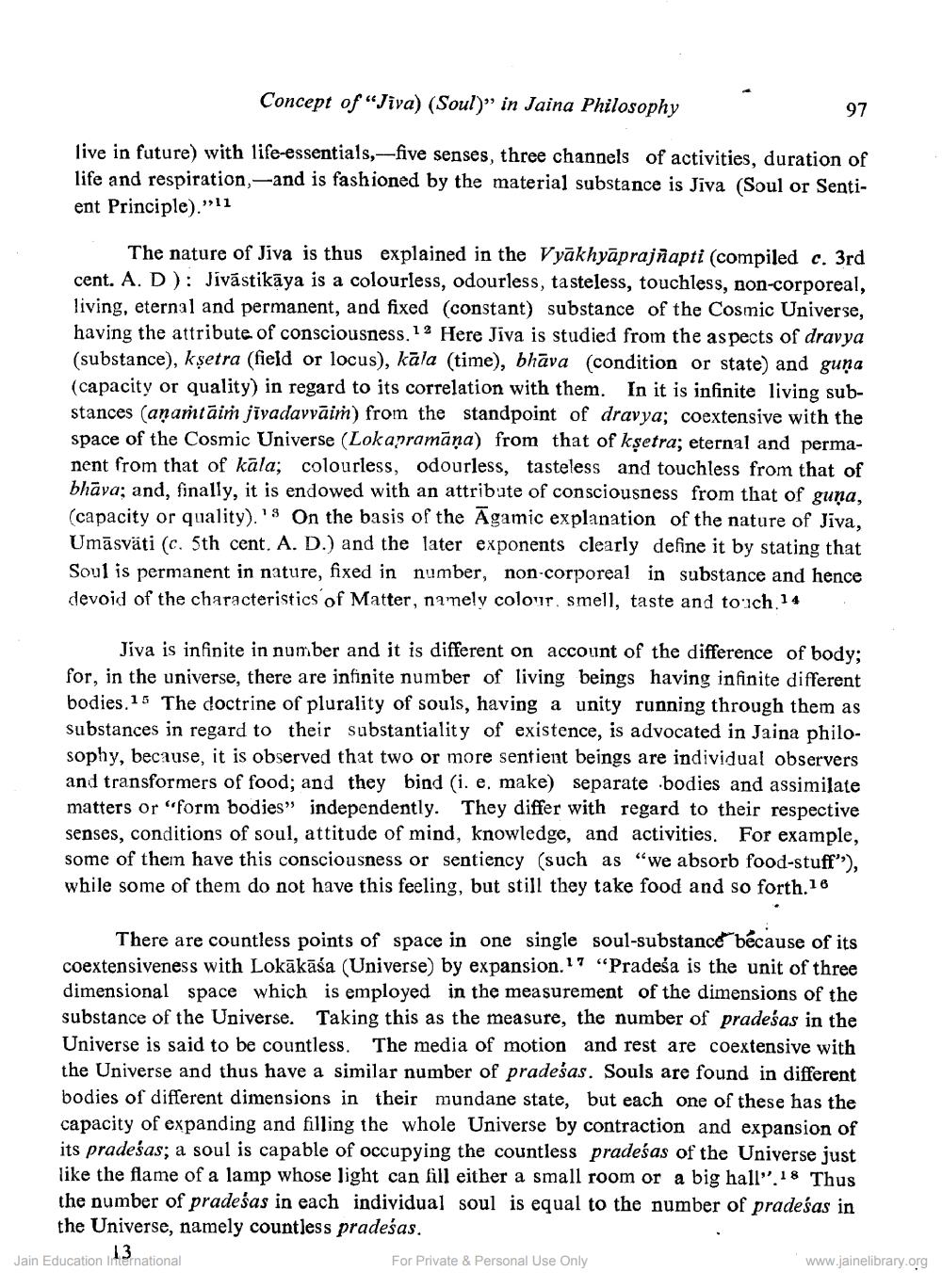Book Title: Concept of Jiva in Jaina Philosophy Author(s): J C Sikdar Publisher: Z_Aspect_of_Jainology_Part_3_Pundit_Dalsukh_Malvaniya_012017.pdf View full book textPage 2
________________ Concept of "Jiva) (Soul)” in Jaina Philosophy 97 live in future) with life-essentials,-five senses, three channels of activities, duration of life and respiration,--and is fashioned by the material substance is Jiva (Soul or Sentient Principle)."11 The nature of Jiva is thus explained in the Vyākhyāprajñapti (compiled c. 3rd cent. A. D): Jivástikāya is a colourless, odourless, tasteless, touchless, non-corporeal, living, eternal and permanent, and fixed (constant) substance of the Cosmic Universe, having the attribute of consciousness, 12 Here Jiva is studied from the aspects of dravya (substance), kşetra (field or locus), kāla (time), bhāva (condition or state) and guņa (capacity or quality) in regard to its correlation with them. In it is infinite living substances (anamtāim jivadavvāim) from the standpoint of dravya; coextensive with the space of the Cosmic Universe (Lokapramāņa) from that of kşetra; eternal and permanent from that of kāla; colourless, odourless, tasteless and touchless from that of bhāva; and, finally, it is endowed with an attribute of consciousness from that of guņa, (capacity or quality). 's On the basis of the Āgamic explanation of the nature of Jiva, Umāsväti (c. 5th cent. A. D.) and the later exponents clearly define it by stating that Soul is permanent in nature, fixed in number, non-corporeal in substance and hence devoid of the characteristics of Matter, namely colour smell, taste and touch.14 Jiva is infinite in number and it is different on account of the difference of body; for, in the universe, there are infinite number of living beings having infinite different bodies. 15 The doctrine of plurality of souls, having a unity running through them as substances in regard to their substantiality of existence, is advocated in Jaina philosophy, because, it is observed that two or more sentient beings are individual observers and transformers of food; and they bind (i. e, make) separate bodies and assimilate matters or "form bodies” independently. They differ with regard to their respective senses, conditions of soul, attitude of mind, knowledge, and activities. For example, some of them have this consciousness or sentiency (such as “we absorb food-stuff'), while some of them do not have this feeling, but still they take food and so forth.16 There are countless points of space in one single soul-substance because of its coextensiveness with Lokākāśa (Universe) by expansion.17 “Pradeśa is the unit of three dimensional space which is employed in the measurement of the dimensions of the substance of the Universe. Taking this as the measure, the number of pradeśas in the Universe is said to be countless. The media of motion and rest are coextensive with the Universe and thus have a similar number of pradešas. Souls are found in different bodies of different dimensions in their mundane state, but each one of these has the capacity of expanding and filling the whole Universe by contraction and expansion of its pradeśas; a soul is capable of occupying the countless pradeśas of the Universe just like the flame of a lamp whose light can fill either a small room or a big hall”. 18 Thus the number of pradeśas in each individual soul is equal to the number of pradeśas in the Universe, namely countless pradeśas. Jain Education national For Private & Personal Use Only www.jainelibrary.orgPage Navigation
1 2 3 4 5 6 7 8 9 10 11 12 13 14 15 16 17 18 19 20 21 22 ... 24
